The Beach!

The singular most important feature of Long Beach--it's what gives the City its name!

Our beach is indeed long (5 miles?). And sadly, it receives little love from many residents of Long Beach who view it as trashed, dirty, or just not fun.
I wish I could say that all our beach-haters were blowing smoke. But they are justified in complaining about our beach. Recent water quality tests indicated that water quality was very poor here. However, our beach fared better in previous years, so hopefully this is a temporary downturn.
Other factors conspire to make our beach among the least loved, most polluted in southern California. Fed by both the Los Angeles and San Gabriel rivers, all the trash and litter from millions of Los Angeles and Orange County residents washes into our harbor. The breakwater that keeps our port safe for large cargo ships prevents the normal oceanic flushing that would remove most of this trash, which consequently ends up on our shores. Adding insult to injury, this breakwater eliminates the wave action that is necessary for that quintessential California beach activity: surfing. The environmental group Surfrider (which has a Long Beach chapter) is actively campaigning to have part of this breakwater removed. All these factors, combined with the unsettling sites of offshore oil rigs and huge cargo boats plying our harbor makes our beach an offputting destination for many people.
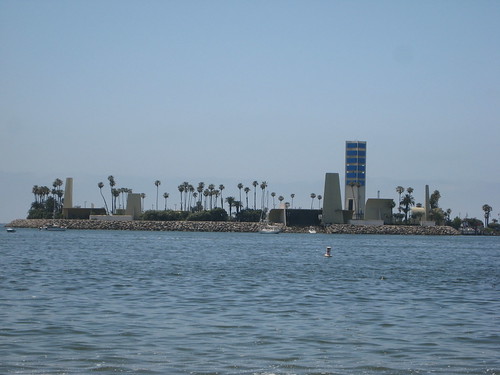
Off-shore oil rigs are decorated to make these artificial islands look like fantasy-cities
It's a shame. Despite all these factors, The Beach remains one of the best destinations for recreation, as well as for natural history. And a side bonus is that you get a lot more solitude and privacy in Long Beach than you would at, say, Huntington Beach. Less people-watching means better bird-watching, in general.
The most conspicuous wildlife to observe at the beach are the seabirds. Gulls (family Laridae) are usually the most obvious birds, as they are loud and fearless animals, allowing people to get very close. There are many species in southern California, and each species has many different appearances (depending on age, sex, and season), making identification extremely difficult! In general, it helps to notice things like the color of the beak, feet, eyes, and eye-rings. This flock shows the diversity of shapes, colors, and sizes of our gulls:

Flock of seagulls
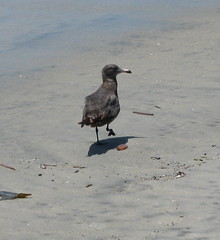
Heerman's gull (Larus heermanni), juvenile

Heerman's gull (Larus heermanni), adult
Terns are another common sighting at the beach. These are smaller and more gracefull than our gulls. In Long Beach, you can find several species, including elegant and Caspian terns. In the summer of 2006, a tern colony on an abandoned barge--the northernmost tern colony in the world--was destroyed by using a high-pressure water hose. Hundreds of dying fledglings washed ashore. The International Bird Rescue Research Center attempted to save some of these protected birds, but only a small fraction survived. Criminal prosecution against the barge operatore and crew may be underway.
On quieter portions of the beach, such as the peninsula, you may see other shorebirds that are less tolerant of noise and disturbance.

A small group of willets (Catoptrophorus semipalmatus)
Pelicans are another common site from the beach. These large and awkward-looking birds show surprising speed and agility when they nose-dive into the water to catch fish. More often, they are seen slowly gliding in small groups, looking like miniature pterodactyls. Two species are found here--the white (Pelecanus erythrorhynchos) and the brown (P. occidentalis). Both are protected by federal law. Recently, several of these birds were found mutilated (their pouches slit open) in Orange County in 2006. The perpetrators were never found, but the prevailing assumption is that they were fishermen concerned about competition.
In addition, grebes, cormorants, and sea-ducks (like surf scoters and mergansers) are commonly seen swimming off shore.
If you go to Belmont Memorial Pier at night, you are bound to encounter another fascinating creature:
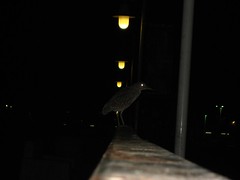
A juvenile black-crowned night heron (Nycticorax nycticorax).
Of course you may see them during the day as well:

A juvenile black-crowned night heron
These birds are presumably attracted to the bait left behind by fishermen on the pier. At night, you can hear them make their bizarre calls.
These birds
In addition to birds, you may be lucky enough to see California sea lions (Zalophus californianus, common short-beaked (Delphinus delphis) and long-beakd (D. capensis) dolphins, or bottlenose dolphins (Tursiops truncatus) swimming offshore, although all of these are rare occasions, especially within the breakwater of Long Beach. Sometimes, large fish like barracuda will jump above the surface of the water near shore. So keep your eyes peeled!
On even rarer occasions, you may even see a whale. A dead whale washed ashore just a few miles downshore on March 23, 2007 [ref].
A stroll down the beach will invariably yield some fascinating sea-wrack and other interesting gifts from the sea (as well as a distressing quantity of garbage). Some things you are likely to encounter are seaweeds.
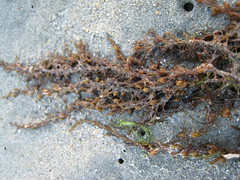
Brown algae (Phaeophyta)
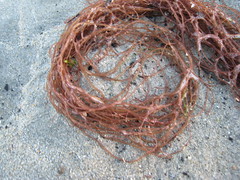
Red algae (Rhodophyta)
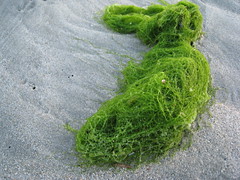
Green algae (Chlorophyta)
Kelp is one of the most conspicuous and massive seaweeds that wash ashore:
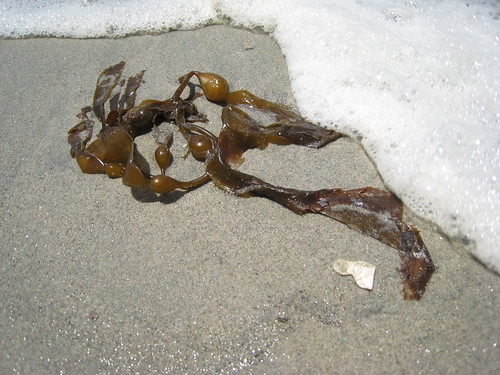
Kelp is a brown algae, and is one of the fastest growing organisms on the planet (growing over 1 foot a day during the summer). Large kelp bounds are found off-shore near the Palos Verdes peninsula and around Catalina Island, forming submarine forests that support nurseries of game fish, as well as marine mammals.
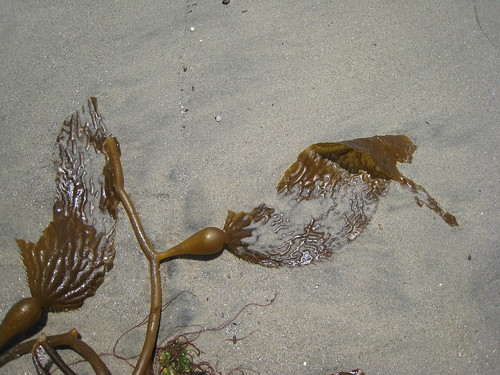
Giant kelp (Macrocystis pyrifera), a common species of the California kelp forests.
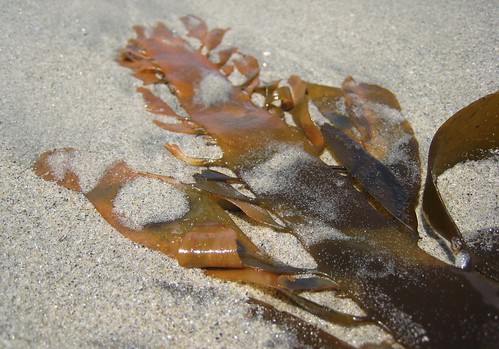
Need ID (Need ID)
Gas-filled bladders help kelp remain upright in the water and grow towards the sun:

Kelp live in very turbulent oceans, which would tear most plants to shreds. Kelp, though, is made of extremely tough, yet flexible material which is almost impossible to tear.
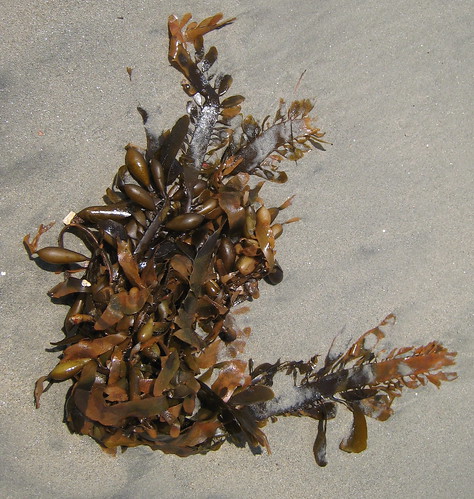
Furthermore, they are cemented to hard surfaces by their holdfasts:
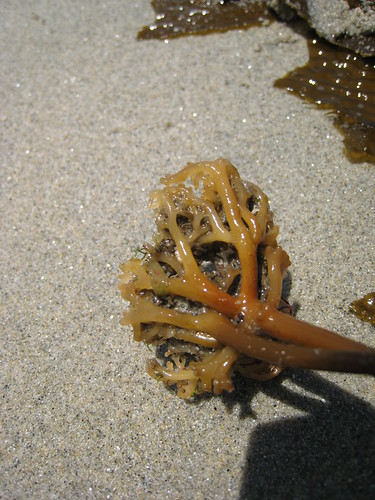
More often than not, the plant can withstand far more abuse than the rock to which it is attached. In the photo below, the disoldged plant tore off parts of the bedrock with it when it was uprooted.

A kelp holdfast. This one shows coloinzation by other organisms, such as the coralline algae (the red, feathery structures) and by a colonial bryozoan, the white, encrusting growth at the bottom of the holdfast.
If you poke around the blades of the seaweeds, you are likely to encounter all sorts of wildlife, like small crabs, shrimp, worms, and who knows what else!
Many transit lines take you to the beach, as do all the major bikepaths. For bus service, take the Passport (A and D), #21, 22, 23, or 131.
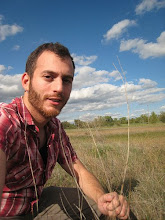

1 comment:
The "Need ID" kelp is feather-boa kelp, Egregia menziesii.
Post a Comment